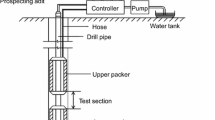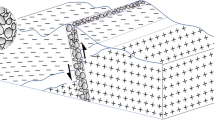Abstract
A reservoir impoundment located near a tunnel structure negatively affects groundwater seepage to varying degrees. This can result in water inflow, structural collapse, and other engineering hazards during tunnel excavation. In addition, in cold regions, reservoir impoundment and water seepage can exacerbate frost heave damage during tunnel operations. This paper describes a comprehensive case study on the quantitative evaluation of the seepage effects of the proposed Longsheng Reservoir on the adjacent proposed Kouzi village tunnel (located in Ulanchap, Inner Mongolia, North China). An engineering geology survey was conducted to identify the topography and geological features in the tunnel and reservoir area. A geohydrological survey was conducted to identify groundwater runoff patterns and to assess the possible seepage paths. Pumping and injection tests were conducted to characterize the in-situ permeability of the strata. Based on the detailed field information, the seepage field and stress field of the study area were investigated using COMSOL Multiphysics and ABAQUS software. From these numerical simulations, the evolution of the water inflow and the stress/strain field in the shallow buried section of the tunnel could be predicted quantitatively at different construction and operation stages. This study showed that the seepage influence of the Longsheng Reservoir on the Kouzi village tunnel during the excavation and operational stages will be relatively weak. However, structural collapse of the tunnel and water inflow are likely to occur beneath the two gullies. Mitigation measures such as impervious walls and inverted arch structural elements were proposed to address these potential hazards.




























Similar content being viewed by others
References
Bronfenbrener L, Bronfenbrener R (2010) Modeling frost heave in freezing soils. Cold Reg Sci Technol 61(1):43–64
Cai L (2011) Three dimensional numerical simulation of influence of reservoir impoundment on groundwater seepage in reservoir area. Dissertation, Chengdu University of Technology (in Chinese)
Cannata M, Marzocchi R (2012) Two-dimensional dam break flooding simulation: a GIS-embedded approach. Nat Hazards 61(3):1143–1159
Chapuis RP (2004) Predicting the saturated hydraulic conductivity of sand and gravel using effective diameter and void ratio. Can Geotech J 41(5):787–795
Chapuis RP, Aubertin M (2003) On the use of the Kozeny–Carman equation to predict the hydraulic conductivity of soils. Can Geotech J 40(3):616–628
Chu-Agor ML, Fox GA, Cancienne RM, Wilson GV (2008) Seepage caused tension failures and erosion undercutting of hillslopes. J Hydrol 359(3–4):247–259
Coli N, Pranzini G, Alfi A, Boerio V (2008) Evaluation of rock-mass permeability tensor and prediction of tunnel inflows by means of geostructural surveys and finite element seepage analysis. Eng Geol 101(3–4):174–184
Deng W (2010) Analysis of interaction between mountain highway tunnel and adjacent reservoir. J Northwest Univ (Nat Sci Ed) 40:25–28 (in Chinese)
Deng G, Wang JY, Zheng JL (2009) Influences of lining stiffness distribution on frost heave pressure on cold regional tunnels. J Southwest Jiaotong Univ 44(5):716–720 (in Chinese)
Hou W (2006) Study of influence of high water head on seepage of tunnel based on GEO-SLOPE. J Xi’an Univ Technol 22(2):171–174 (in Chinese)
Huang Y, Bao Y, Wang Y (2015a) Analysis of geoenvironmental hazards in urban underground space development in Shanghai. Nat Hazards 75(3):2067–2079
Huang JH, Xia CC, Han CL, Huang M (2015b) Analytical solution of frost heave force action on cold-region tunnel liner considering anisotropy frost heave of surrounding rock. Chin J Rock Mech Eng 34(Suppl 2):3766–3774 (in Chinese)
Jean JS (1996) Pumping testing using a siphon well. Water Resour Manag 10:81–105
Jiang ZX (2005) Interaction between tunnel engineering and water environment. Chin J Rock Mech Eng 24(1):121–127 (in Chinese)
Lee IM, Nam SW (2001) The study of seepage forces acting on the tunnel lining and tunnel face in shallow tunnels. Tunn Undergr Sp Tech 16:31–40
Li B (2012) A quick solution method for calculating permeability coefficient of aquifer by single well pumping test. J Wuhan Univ Technol (Transport Sci Eng) 36(5):1025–1027 (in Chinese)
Li P, Lu W, Long Y, Yang Z, Li J (2008) Seepage analysis in a fractured rock mass: the upper reservoir of Pushihe pumped-storage power station in China. Eng Geol 97(1–2):53–62
Li D, Li X, Li CC, Huang B, Gong F, Zhang W (2009) Case studies of groundwater flow into tunnels and an innovative water-gathering system for water drainage. Tunn Undergr Sp Tech 24(3):260–268
Ma J (2008) Observation and analysis of Lijiahe tunnel seepage of Lan-Shang highway. Dissertation, Xi’an University of technology (in Chinese)
Ma L, Xu YS, Shen SL, Sun WJ (2014) Evaluation of the hydraulic conductivity of aquifers with piles. Hydrogeol J 22(2):371–382
Masrouri F, Bicalho KV, Kawai K (2008) Laboratory hydraulic testing in unsaturated soils. Geotech Geol Eng 26(6):691–704
Mimouni T, Dupray F, Laloui L (2014) Estimating the geothermal potential of heat-exchanger anchors on a cut-and-cover tunnel. Geothermics 51:380–387
Ministry of Housing and Urban-Rural Construction of the People’s Republic of China (2014) GB/T 50218-2014. Standard for engineering classification of rock masses (in Chinese)
MOC (2010) JTG/T D70-2010. Guidelines for design of highway tunnel (in Chinese)
Moon J, Jeong S (2011) Effect of highly pervious geological features on ground-water flow into a tunnel. Eng Geol 117(3–4):207–216
Ni JC, Cheng WC, Ge L (2013) A simple data reduction method for pumping tests with tidal, partial penetration, and storage effects. Soils Found 53(6):894–902
Ou CY, Chen SH (2010) Performance and analysis of pumping tests in a gravel formation. B Eng Geol Environ 69(1):1–12
Perazzelli P, Leone T, Anagnostou G (2014) Tunnel face stability under seepage flow conditions. Tunn Undergr Sp Tech 43:459–469
Ren X (2004) Main water problems and countermeasures of deep buried long tunnel in water rich area. Chin J Rock Mech Eng 23(11):1924–1929 (in Chinese)
Shen SL, Xu YS (2011) Numerical evaluation of land subsidence induced by groundwater pumping in Shanghai. Can Geotech J 48:1378–1392
Shen SL, Wu HN, Cui YJ, Yin ZY (2014) Long-term settlement behaviour of metro tunnels in the soft deposits of Shanghai. Tunn Undergr Sp Tech 40:309–323
Shen SL, Wu YX, Xu YS, Hino T, Wu HN (2015) Evaluation of hydraulic parameters from pumping tests in multi-aquifers with vertical leakage in Tianjin. Comput Geotech 68:196–207
Uromeihy A, Barzegari G (2007) Evaluation and treatment of seepage problems at Chapar-Abad Dam, Iran. Eng Geol 91(2–4):219–228
Water Resources and Hydropower Planning and Design (2008) GB50487-2008. Code for engineering geological investigation of water resources and hydropower (in Chinese)
Wu HN, Huang RQ, Sun WJ, Shen SL, Xu YS, Liu YB, Du SJ (2014) Leaking behavior of shield tunnels under the Huangpu River of Shanghai with induced hazards. Nat Hazards 70(2):1115–1132
Wu YX, Shen SL, Yuan DJ (2016) Characteristics of dewatering induced drawdown curve under blocking effect of retaining wall in aquifer. J Hydrol 539:554–566
Xue YQ, Wu JC (2010) Groundwater dynamics. Geological Publishing House, Beijing (in Chinese)
Yang FR, Lee CH, Kung WJ, Yeh HF (2008) The impact of tunneling construction on the hydrogeological environment of “Tseng-Wen Reservoir Transbasin Diversion Project” in Taiwan. Eng Geol 103(1–2):39–58
Zarei HR, Uromeihy A, Sharifzadeh M (2011) Evaluation of high local groundwater inflow to a rock tunnel by characterization of geological features. Tunn Undergr Sp Tech 26(2):364–373
Zhao D (2005) Study on the influence of reservoir impounding on the operation safety of existing mountain railway tunnel. Mod Tunn Technol 42(6):30–35
Zhou ZF, Tang RL, Wang B (1999) Determination of hydrogeological parameters of leaky aquifer based on pumping test data of partially penetrating well near the boundary. Journal of Hehai University (Natural Science) 27(3):5–8 (in Chinese)
Acknowledgments
This work is supported by the National Natural Science Foundation of China (nos. 41572301, 41330634, and 61427802) and the Fundamental Research Funds for the Central Universities of China (no. 2-9-2015-071). The authors would also like to acknowledge the anonymous reviewers for their valuable comments and suggestions, which helped to significantly improve the quality of this paper.
Author information
Authors and Affiliations
Corresponding author
Rights and permissions
About this article
Cite this article
Zhang, B., Wang, Hx., Ye, Yw. et al. Potential hazards to a tunnel caused by adjacent reservoir impoundment. Bull Eng Geol Environ 78, 397–415 (2019). https://doi.org/10.1007/s10064-017-1110-8
Received:
Accepted:
Published:
Issue Date:
DOI: https://doi.org/10.1007/s10064-017-1110-8




